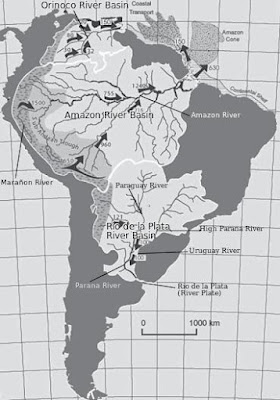All three main South American river basins drain their three respective regions into the Atlantic Ocean. Those river systems that flow into the Pacific are very small and have little importance from a hydrological point of view. Although most of the fresh water they drain comes from rain water, about 15% of the water is from thawing snow piled up in the high-altitude gullies of the Andes Mountain Range. The major river basins of South America are:
1) The Amazon River Basin. It is the largest river system in the world, followed by the Mississippi, Volga, and Nile basins. The Amazon river rises in the Peruvian Andes under the name of Marañon River. As soon as it flows into Brazil, it changes its name and it is called Amazon, whose main tributaries are the Ucayali, Putumayo, Jura, Japura, and Madeira River. Half of Brazil, 60% of Peru, and 40% of Bolivia are drained by this river system.
2) The Rio de la Plata River Basin. It is the second largest fluvial system in South America. It drains a vast region, which includes Paraguay, Southern Brazil, Uruguay, and Argentina. The main water course is the Parana River, which receives waters from the Paraguay and Salado River. When the Parana joins the Uruguay River, they form the Rio de la Plata.
3) The Orinoco River Basin. Its main water course is the Orinoco River. Some of its left hand tributaries originate from streams in the Venezuelan Andes Range. The Orinoco and its tributaries drain most of the Venezuelan territory, including the large grassy plain, called Llanos del Orinoco.
Below, a map of South America showing you the three major basins of South America.












